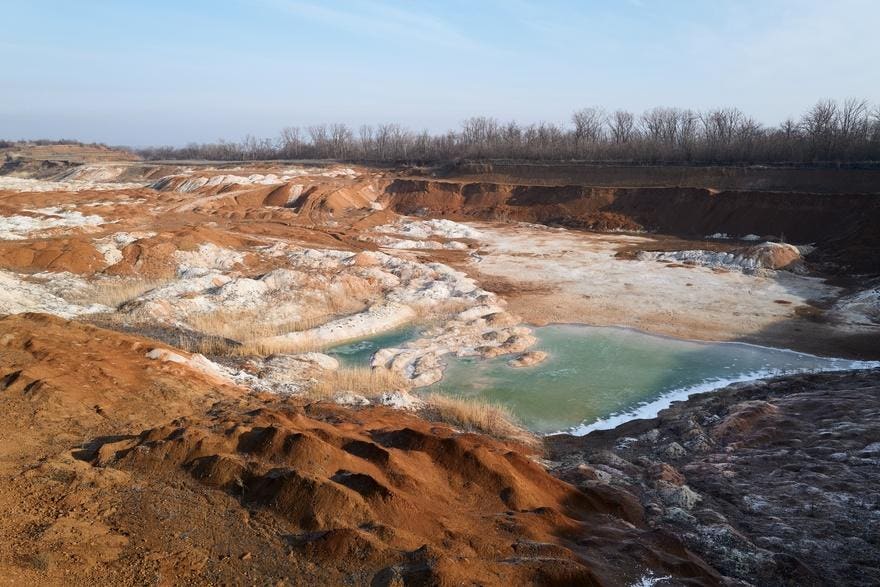By Jack Conness, Senior Policy Analyst, Energy Innovation
DONETSK REGION, UKRAINE – FEBRUARY 12: A vast open-pit mine stretches across the landscape on … [+]
The Trump administration is clear: Securing a minerals supply chain is a priority. Yesterday, reports emerged that the United States and Ukraine reached a minerals deal. While details are still unconfirmed, the U.S. is rumored to gain access to Ukrainian mineral deposits and revenue from those deposits in exchange for American aid.
It is certainly true that securing a supply chain for critical minerals is an important priority. But what does Ukraine offer in terms of mineral resources, and does it help secure an American minerals supply chain?
While the deal poses limited economic risk for the U.S., the chances of seeing actual minerals extracted from the ground that enter our supply chain is limited and comes with risk due to their location in an active conflict zone.
First, it’s important to understand what minerals are at play. Many media reports use “minerals” or “rare earth elements” as a catch-all, but the details matter here. Rare earths are a collection of 17 minerals where neodymium, dysprosium, and terbium are often considered the most desired. Despite their misleading name, rare earths are not rare and are found throughout all parts of the world. However, economically recoverable rare earth deposits are hard to come by and rare earths do not include things like graphite, lithium, and cobalt – those are different minerals that are also important for making critical materials we rely on, but they are not one of the 17 “rare earths.”
Rare earths have been a primary focus for the first and second Trump administrations. Global economies only need small quantities of rare earths compared to other minerals, and their magnetic, luminescent, and electrical properties play an extremely important role in defense and energy technologies. The world’s current rare earths supply chain is almost exclusively found in China, which accounted for 69 percent of global production/extraction in 2024 and composed 92 percent of global rare earths refining output.
However, rare earths are found in other parts of the world like the U.S., Canada, Brazil, Australia, and India. Furthermore, the search for rare earths is underway with resources being discovered in multiple nations – finding rare earths is often a top priority for nations looking to diversify their mineral supply chains.
Does Ukraine Have Economically Accessible Mineral Deposits?
Little information exists as to whether Ukraine actually has economically accessible rare earths deposits (i.e., reserves). As I wrote about American lithium last April, mineral estimates are not resources, and resources are not reserves. Reserves are the real holy grail of mineral classifications. To move from estimates to resources to reserves, a mineral needs to be thoroughly vetted, tested, and eventually deemed technologically and economically viable for extraction.
This can take some time and can often be a moving target. Case in point, Canada has 830,000 tons of rare earth reserves, but over 14 million tons of rare earth resources. The U.S. Geological Survey’s (USGS) most recent Mineral Commodity Summaries does not list Ukraine as having any rare earths reserves. The country also has zero existing rare earths mines, processing facilities. or known reserves.
Global rare earth element production and reserves
To make matters murkier, the former Ukraine Geological Survey (UGS) Director General Roman Opimakh said there is “no modern assessment” of rare earth reserves in Ukraine and most mineral mapping was done between the 1960s and 1980s. The Trump administration has expressed interest in other minerals like lithium, graphite, and titanium, but these are based on rough mineral estimates. In 2022, the National Academy of Sciences of Ukraine (NAS) published a report estimating 500,000 tons of lithium oxide reserves around the country. Yet, the USGS shows zero identified lithium resources or reserves. Furthermore, Ukraine has no operational lithium mines.
The UGS claims the country has some of the largest graphite reserves in the world, but Ukraine’s reserve amount does not even register in USGS estimates. Their graphite production in 2019 (pre-COVID and pre-war) was 20,000 metric tons – less than 2 percent of global production. Ukraine does produce titanium, a mineral the Trump administration has shown additional interest in, but their production and reserves are negligible, according to the USGS.
In addition to relatively unknown mineral amounts, many of their mapped deposits are in major conflict zones – particularly eastern Ukraine, where Russia has varying degrees of control.
Ukraine’s mineral resources, graphic via The Guardian
What’s Next For America’s Domestic Mineral Supply Chain?
Bottom line, even if America secures rights to Ukraine’s minerals, adding much additional security for our mineral supply chain is far from a sure thing.
If the estimated mineral deposits exist, very little research has examined if they are extractable at a reasonable cost. Even then, this does not consider the Russian conflict or depleted transportation and energy infrastructure. And Ukraine has far greater concerns right now than building mineral infrastructure.
This all adds up to a tough investment outlook for any business looking at Ukraine’s mineral supply.
If America was truly seeking mineral trade alliances that benefit domestic supply chains, we already have ample opportunities in nations like Canada, Australia, Chile, and Argentina. Canada has vast titanium, graphite, and nickel resources, while Australia has significant lithium reserves despite most U.S. lithium coming from Chile and Argentina.
Here at home, multiple lithium and rare earth opportunities are already being explored within U.S. borders. Developing natural resources in regions of the world with strong environmental and labor standards, then applying those strong standards to development, should be a priority when considering where to source our needed minerals.
But instead of exploring these opportunities, the U.S. has imposed strict tariffs on allied countries like Canada and Australia, which hurts our prospects to build a secure mineral supply chain in partnership with allies, while tarnishing important relationships that have been built over decades.
The proposed mineral deal with Ukraine poses seemingly little economic downside for the U.S. – in theory, America will reap the rewards of whatever minerals are – if ever – extracted or processed in Ukraine. But that economic upside may not materialize, Benchmark Minerals’ Daan de Jonge stated the “rare earth demand as it stands today does not exceed $20 billion” – a far cry from the administration’s previous demand for “$500 billion dollars’ worth of rare earth.”
Depending on the final details, this deal may not deliver much substance in terms of minerals access or economic value for America, and may simply be strongarming an ally that needs aid as they resist an ongoing invasion.


